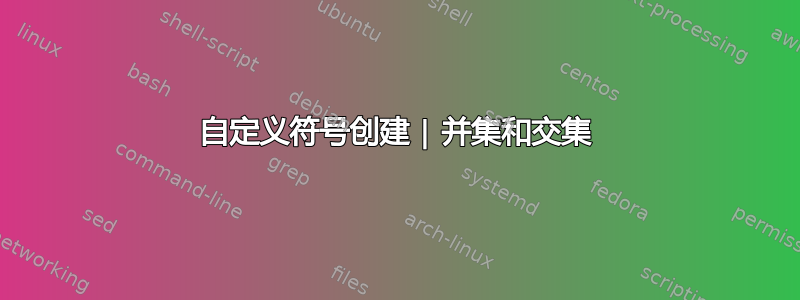
我是 LaTeX 的初学者,想知道是否有人可以帮助我解决以下问题。
我很快就要开始重新格式化某篇文章,我相信我已经涵盖了大部分解决方案。然而,有一个超出了我目前的知识水平。作者使用了某种自定义符号我无法重现。请查看以下屏幕截图:
我尝试过将\cup和连接\cap在一起并调整它们的位置,但结果并不令人满意。在寻找解决方案时,我偶然发现了这篇文章:
我对蒂克兹和前列腺素F包裹。然而,当我打开Tikz 和 PGF 手册,我明白我无法很快找到解决方案。
我想寻求帮助来使用创建上述符号\usepackage{tikz},除非有更好的解决方案来获得相同的结果?
答案1
您可以使用picture具有以下增强功能的环境pict2e包裹。
\documentclass{article}
\usepackage{pict2e}
\newcommand*{\cupcap}{%
\mathrel{%
\begin{picture}(8,8)
\roundcap
\put(0,2){\line(0,1){5}}
\put(2,2){\arc[180,360]{2}}
\put(4,2){\line(0,1){3}}
\put(6,5){\arc[180,0]{2}}
\put(8,0){\line(0,1){5}}
\end{picture}%
}%
}
\begin{document}
\( X \cupcap Y \)
\end{document}
答案2
欢迎来到 StackExchange!
这是符号及其镜像。我已经注释了代码,以便您可以根据自己的喜好进行调整。我为此寻找了 Unicode 符号,但一无所获。很奇怪——我敢发誓我曾在印刷品中见过这个符号。
\documentclass[]{standalone}
\usepackage{tikz}
\def\symbol{%
\mathrel{%
\begin{tikzpicture}[baseline]% Makes sure that the symbol is on the baseline
\def\r{0.18em}% radius of the arc
\def\h{0.475em}% determines height of the symbol
\draw[line width=0.06em](0,\r+\h) -- %% Adjust line width to suit
(0,\r)
arc (180:360:\r) -- %% the lower arc overshoots the baseline as it should
(2*\r,\h)
arc (180:0:\r) --
(4*\r,0);%
\end{tikzpicture}%
}%
}
\def\ssymbol{% reflected
\mathrel{%
\begin{tikzpicture}[baseline]% Makes sure that the symbol sits on the baseline
\def\r{0.18em}% radius of the arc
\def\h{0.475em}% determines height of the symbol
\draw[line width=0.06em](0,0) -- %% Adjust line width to suit
(0,\h)
arc (180:0:\r) --
(2*\r,\r)
arc (180:360:\r) -- %% the lower arc overshoots the baseline as it should
(4*\r,\h+\r);%
\end{tikzpicture}%
}%
}
\begin{document}
$x^2\symbol Z$ or $A\ssymbol B$
\end{document}
答案3
含 Ti 的解决方案钾Z:
\documentclass{article}
\usepackage{tikz}
\newcommand*{\cupcap}{\mathrel{%
\def\hs{0.62em}%heigth symbol
\def\ws{0.9*\hs}%width symbol
\def\lw{0.12*\hs}%line width
\tikz[baseline=0pt]{
\draw[rounded corners=0.15*\hs,%<-roundness of the symbol
line width=\lw]%
(0,0) -- ++(0,\hs+0.5*\lw) -- ++(-0.5*\ws,0) -- ++(0,-\hs) --
++(-0.5*\ws,0) -- +(0,\hs+0.5*\lw);%
}%
}%
}
\begin{document}
\( \mathsf{X} \cupcap \mathsf{Y} \)
\end{document}







